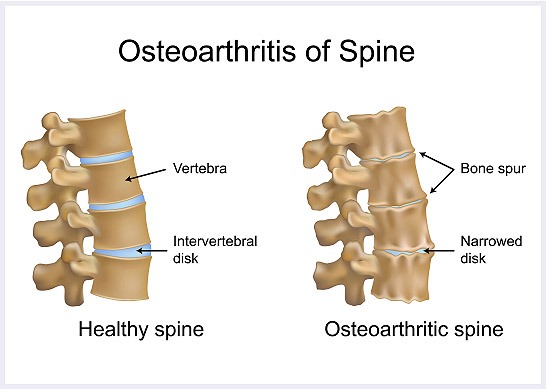Back Pain Treatment Home » Conditions Treated » Osteoarthritis of the Spine
Osteoarthritis is also known as degenerative joint disease
Osteoarthritis of the spine is a breakdown of the cartilage of the facet (also known as zygapophyseal “z”) joints in the spine. Sometimes, osteoarthritis produces spurs that put pressure on the nerves leaving the spinal column, causing pain, numbness/tingling or weakness in the arms or legs.
Who Gets Osteoarthritis of the Spine?
In general, osteoarthritis happens as people get older and is more common among people who are overweight. For people younger than age 45, osteoarthritis is more common among men. After age 45, osteoarthritis is more common among women. It also occurs more frequently in those who have jobs or do sports that put repetitive stress on the spine, such as lifting and twisting activities.

What Are the Symptoms of Osteoarthritis of the Spine?
How Is Osteoarthritis of the Spine Diagnosed?
Symptoms of morning stiffness that improves with activity, low back pain that worsens with walking or standing and relieved by sitting (spine flexion) is suggestive of osteoarthritis of the spine. On physical examination, neck pain or low back pain that worsens with leaning back (extension) and twisting is also suggestive of osteoarthritis of the spine as is tenderness over the facet joints.
XRay is not that helpful in diagnosing osteoarthritis of the spine because it is so commonly found on XRay even in those not suffering from neck or back pain.
The best way to confirm a diagnosis of osteoarthritis of the spine is by having a Pain physician inject the facet joints or the nerves that supply them (medial branches) with local anesthetic under XRay guidance (fluoroscopy). If the pain in the neck or lower back improves more than 80% within one hour of the procedure, the diagnosis is made of osteoarthritis of the spine.
The doctor may order certain tests to aid in the diagnosis of osteoarthritis of the spine. These tests include:
- X-rays looking for bone damage, bone spurs, and loss of height; however, X-rays are not able to show early damage to cartilage or signs of inflammation in the joints.
- Blood tests to exclude other diseases.
How Is Osteoarthritis of the Spine Treated?
There’s no cure for osteoarthritis of the spine, and the condition isn’t reversible. In most cases, treatment of spinal osteoarthritis is geared toward relieving the symptoms of pain and increasing a person’s ability to function.
It is a good idea to try physical therapy including strengthening of the core and stretching the muscles around the spine, as a treatment of neck or back pain. Physical therapy can treat neck or back pain due to both osteoarthritis and muscle spasm/weakness.
Short Term Treatments
- Nonmedication treatments - massage, acupuncture, heat or cold compresses, losing weight, transcutaneous electrical nerve stimulation (TENS), nutritional supplements
- Exercise
LONG Term Treatments



